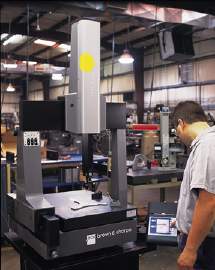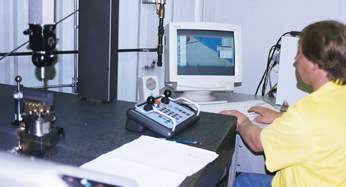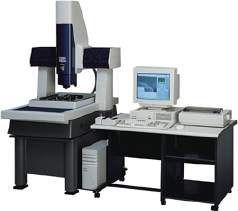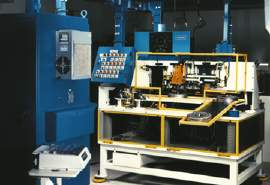|
Precision Machine Shop Moves Forward with Reverse Engineering Applications
Machine Specialties Inc. in Ashland, Virginia, produces close-tolerance replacement components such as gears and shafts for production machinery. Recently, the company expanded its market by adapting the same machining techniques to components for the bottling and baking industries.
"Those industries often purchase production machinery made overseas and sometimes have difficulty getting replacement parts quickly," says Machine Specialties' Hunter Freed. "We saw an opportunity to sell our machining expertise to those industries, making replacement parts."
These manufacturers often need to make adjustments to production machines, changing a gear ratio or modifying the shape of a mold, notes Freed. "Having a precision machining facility nearby that can turn work around quickly gives them the confidence to do this," he explains.
Since its founding in 1983, Machine Specialties has offered high-technology CNC and conventional milling and turning. They also have cylindrical and surface grinding capabilities, and more recently, water jet machining. To complement its machining capability, the company added a new Brown & Sharpe GAGE 2000 R measurement station.
GAGE 2000 R is designed to be used as a height gage, calipers, dial indicator or a full-featured coordinate measuring machine. It also offers hard probe scanning in all modes. During scanning, its software uses a unique "speedometer" that graphically indicates the quality of the measurement data being collected, based on probe speed. This speed-sensitive guidance system allows the operator to modify the measuring technique to assure accurate data collection.
The main software menu includes a selection labeled "Digitize." This mode is used in reverse engineering applications to gather XYZ ball center points and send them to a collection point via the serial port, to be converted into either DXF or IGES format for easy assimilation into a CAD system.
At Machine Specialties, data collected during the reverse engineering operation will be transferred in DXF format to the company's Omax 2652 Water Jet Machining Center, where the data is used to create machining paths.
"The GAGE 2000 will let us create DXF files more quickly and efficiently than we could if someone manually measured all of the critical dimensions of a part, then created a part drawing which we would turn into a DXF file," notes Freed. "We're being asked more frequently for just-in-time delivery, and the GAGE 2000 R will help us meet these critical deadlines."
While the GAGE 2000 was purchased primarily for reverse engineering applications, it will work its way into other applications as well, predicts Freed. In one instance, gear boxes machined by the company were slated to bypass normal acceptance testing by the customer. Machine Specialties was asked to provide certification that all the dimensions on the part drawing were within specifications.
The results of the measurements collected by the GAGE 2000 were sent to a printer via the system's parallel port. The results can be printed in text format, graphically or both. At the part inspection's completion, the part drawing on the screen can also be printed with the part's digitized outline. All features are numbered and correlate to the numeric identifiers of the results printed earlier, making clear what features were inspected.
Because of its simple operation, the GAGE 2000 probably will be integrated more fully into machining operations at Machine Specialties, from first piece inspection to tool setup.
For more information, circle reader service number 151.
Brown & Sharpe GAGE 2000 R Measurement Station
www.brownandsharpe.com
Benefits
Multipurpose dimensional gaging--height gage, calipers, dial indicator
Offers hard probe scanning in all modes
"Speedometer" provides quality of data feedback
nInterfaces with CAD systems
Software Helps Manufacturer Cut Tool-Inspection Time by 50 Percent
Triple S Plastics, a large, full-service custom injection molder in Vicksburg, Michigan, produces hundreds of part designs from tools and molds it creates at its Tooling & Technology Center. Parts exhibit a high degree of precision and typically are assembled into components for the computer, automotive, instrument and other industries. Experts in mold design and manufacture, Triple S's engineers wanted to be able to guarantee that the tooling produced would in no way deviate from the CAD files they develop on their Cimatron system.
The company accomplishes much of its tool production with electrical discharge machining. To ensure that tooling is correct before use in the EDM, all electrodes of the hundreds of electrodes the company maintains are completely inspected. Yet the turnaround time for tooling creation and part manufacture must be kept to a minimum due to customer delivery needs.
The solution for Triple S was to install an Impact II CNC CMM with VirtualDMIS software. "The combination of CNC and disengageable drives on the Impact II permits manual measuring for single parts and switchability between manual and CNC as needed without rebooting the control system," says Rob Martin, coordinate measuring supervisor.
The VirtualDMIS CAD-integrated software delivers a highly functional yet simple-to-use graphical interface, intelligent measurement, surfacing and pictorial images. "As an operator, a major feature of the software is that all icons appear on a single page, making it very easy to follow and use," explains Martin.
The large graphical area, modeled after those on CAD packages, minimizes on-screen clutter. The software links the company's CAD component data with the CMM inspection process, enabling collection, analysis, display and communication of quality data throughout the manufacturing environment.
For Triple S, VirtualDMIS' big benefit is its ability to translate design data from CAD files directly to a CMM inspection system. The software imports files from the CAD system, and the OPENGL-driven software displays a picture of the part being measured, the fixture, CMM structure and probe. Measuring is "click and point": From the CAD model on the monitor, operators can simply click on a feature and the CMM will measure it. CAD surface data can be imported via VRML, IGES, STEP, DXF and VDA.
In a typical operation at Triple S, once the CAD data is downloaded, a graphical representation of the measured electrode appears on the PC monitor. The operator creates an inspection program simply by clicking on any feature of the model. The CMM is driven automatically along the part surface and collects measurement data.
"I import the IGES file, pick-and-measure from that data, and the software writes the inspection program," says Martin. "The software's pick-and-measure capability has cut inspection time in half."
Every electrode in the plant--40 to 50 daily--is checked with the Impact and VirtualDMIS before it's put on the machine. The software tool inspection capability has also helped reduce the company's cost of quality--which includes rework, scrap and incorrect tooling--to less than 1 percent.
The positive effect on the cost of quality, and measuring efficiency and accuracy can readily be seen at Triple S Plastics.
For more information, circle reader service number 152.
International Metrology Systems VirtualDMIS
www.dmis-cmm.com
Benefits
Cuts inspection time in half
Highly functional, simple-to-use graphical interface and intelligent measurement
Translates design data from CAD files directly to a CMM inspection system
Reduces the company's cost of quality
Company Increases Inspection Throughput with Modernization and Operator Involvement
During the last decade, inspection of machined parts has become a more demanding process. To respond to this, Iowa-based Webber Metals Corp., a contract machine and assembly shop, modernized their inspection lab and involved machine operators in quality control. The manufacturer also switched from conventional mechanical inspection to manual coordinate measuring and noncontact vision inspection. As a result, the company increased inspection throughput an average 10-to-1 and achieved higher part quality overall.
One of the newest players in Webber's quality control scheme is the Mitutoyo Quick Vision 404 noncontact vision measuring machine.
Webber Metals' 200 employees make machined parts for the food, agricultural, aircraft, graphics and construction industries. Mainstay products include flanges, valves, hydraulic cylinders and component assemblies. Average lots run from 100 to 1,000 parts, and each part requires 30 to 130 measurements on average. Inspection sampling rates range from 25 percent to 100 percent, depending on customer requirements, part complexity and part cost. The company operates 24 hours, six days a week and runs as many as 50 different jobs at a time.
The inspection clean rooms contain five Mitutoyo CMMs, one Quick Vision 404 and several hundred mechanical instruments. Inspectors and operators interchangeably verify batch accuracy through the various manufacturing stages. Then, they automatically generate inspection printouts for customers, enabling them to bypass receiving inspection.
Acquisition of the QV 404 noncontact CMM resulted from a potential new job--a gear plate assembly for an ink pump--that proved too sensitive for Webber's existing mechanical contact inspection equipment. When they attempted measuring with the manual CMM, inspection took eight minutes and was unsatisfactory.
To satisfy his customer's requirements and win the new job, Dave Webber, the company's quality assurance manager, began looking for a solution that would be both faster and noncontact. He visited Mitutoyo's headquarters in Aurora, Illinois, where he demoed the powerful QV 404 noncontact vision CMM. Once he chose the QV 404, only two days of training, followed by installation in Webber's clean room, were required to get the inspectors up and running.
The QV 404 offers table dimensions of 493 mm x 551 mm (119.41" x 21.69"), with +/- 0.0001" accuracy on three axes over a 12" surface. It allowed Webber to measure all dimensions of the gear plates in one setup and reduced inspection cycle time from eight minutes to 1.5 minutes.
The QV paid for it itself immediately, and the newest CMM saw its return on investment in six to nine months. "Although we're not a Fortune 500 corporation with limitless funds, our decision to make an investment in quality control has paid off," says Webber.
For more information, circle reader service number 153.
Mitutoyo QV 404
www.mitutoyo.com
Benefits
Increased inspection throughput
Reduced inspection cycle time
High-accuracy, large table dimensions
Higher overall part quality
Automatic Gages Boost Torque Converter Production and Quality
A major automaker has dramatically increased the speed and quality of torque converter production with the assistance of four automatic gaging systems from Federal Products Co. The gages measure up to 11 features on torque converter covers, at throughput rates up to 450 parts per hour. The systems perform fully automatic parts handling and sorting of rejects, and one also deburrs and cleans parts prior to gaging them.
The automatic gaging systems enable the automaker to push through more production at a faster rate, with the quality assurance of 100-percent part inspection. "It would take a human operator with conventional indicator gaging about 15 minutes to perform the same 11 checks that the automated systems perform in eight seconds," says Wayne Brown, senior project engineer at Federal Products. The automatic gages eliminate human error--a significant factor in high-throughput inspection, notes Brown.
Three of the four gaging systems are nearly identical, varying only in certain dimensional specifications to accommodate three slightly different torque converter covers. Each of these three gages integrates four functional stations with a parts handling mechanism and a hybrid PC/PLC control system.
When in use, the system delivers the part to the gage on a conveyor. Then it enters Station 1, where a proximity sensor determines the part's position. A walking-beam mechanism transfers it to Station 2, where electronic gaging transducers measure wall thickness at three locations and main part diameters at four locations. A gaging computer uses this data to calculate parallelism of the part's upper and lower faces, and main diameter taper.
The walking beam then transfers the part to Station 3 for a "dynamic measurement," which involves measuring the part while it rotates on a turntable, to check the flatness of the inside friction face. The gage also measures a small inside diameter of another feature at this station.
At Station 4, bad parts are diverted to a reject chute, while good parts pass through to an outgoing conveyor. Quality personnel can refer to the Federal gaging computer at any time to determine the nature of rejects and decide whether they should be reworked or scrapped.
For more information, circle reader service number 154.
Federal Products Co. Automatic Gaging Systems
www.fedgage.com
Benefits
High throughput
Quality assurance of 100-percent part inspection
A cost-effective approach to a production inspection application
|
 Precision Machine Shop Moves Forward with Reverse Engineering Applications
Precision Machine Shop Moves Forward with Reverse Engineering Applications Manufacturer Cuts Tool- Inspection Time
Manufacturer Cuts Tool- Inspection Time Company Increases Inspection Throughput
Company Increases Inspection Throughput Automatic Gages Boost Torque Converter Production and Quality
Automatic Gages Boost Torque Converter Production and Quality